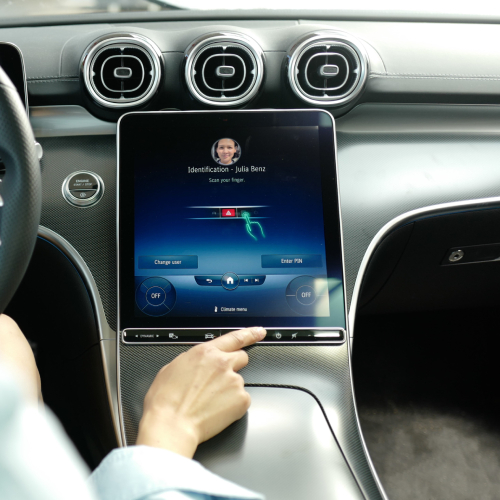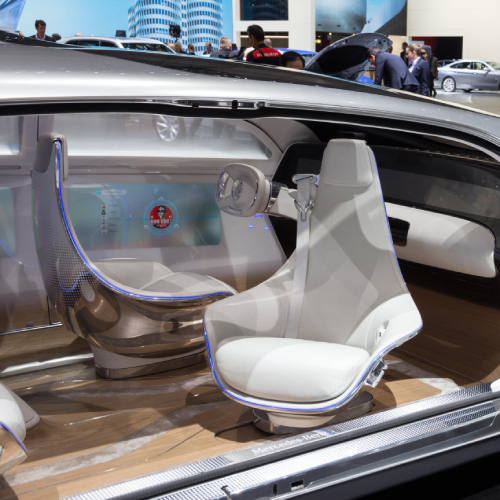Take the wheel: the future of payments in driverless cars
While driverless cars percolate in the collective consciousness as a futuristic innovation that is just on the horizon, there is still some way to go before mass adoption. Driving a car is difficult enough for human intelligences, let alone artificial ones.
It’s not until 2030 at least that mass adoption of driverless cars is widely expected. Despite the long wait, once the market matures, it is set to be massive. According to Renub Research, the US autonomous vehicles market will be worth $186 billion by 2030, up from $4 billion in 2021.
Essentially, autonomous cars will be a reality one day. And the opportunities, once people no longer have to drive their cars, for payments and fintechs alike, are enormous.
Driverless cars will be ready to capitalise on the ever-increasing move towards a cashless society and people’s propensity to stare at screens in order to message, shop, work and play.

Mercedes Pay turns cars into a payment device
In the meantime, by 2026, more than 4.7 billion in-car payment transactions are expected worldwide, according to Juniper Research. And according to McKinsey, by 2030, around 95% of new vehicles sold globally will be set up for payments, up from around 50% in 2021.
Although paying for fuel will initially be the most common use of in-vehicle paytech, accounting for around 48% of total transactions by volume, it’s not hard to imagine that once people no longer have to operate heavy machinery just to get around, this payments infrastructure will be utilised for everything people already use their smartphone for.
Recently, German car manufacturer Mercedes-Benz partnered with payments giant Visa to turn its cars into payment devices.
In a world first, the car manufacturer is utilising Visa’s Delegated Authentication and Cloud Token Framework technology to enable biometric in-car payments, allowing German Mercedes customers to pay for digital services and “on-demand hardware upgrades” in the Mercedes store using a fingerprint sensor.
Mercedes says the payment by car service will be extended to other services such as fuelling as well as to other European markets later this year.
Visa regional managing director for central Europe Albrecht Kiel says: “Making your car a secure and fully authenticated payment device brings new ways to enhance journeys and looking ahead, we can imagine many moments where in-car payments could smoothen the driver experience.”
Your car as your couch
Avin Arumugam, Visa’s senior vice president of Internet of Things, says in an autonomous car, there is no driver’s seat. “Think of your car as your couch.”
As with payments elsewhere, customers’ desire for reduced friction, enhanced connectivity and convenience will drive innovation in in-vehicle paytech.
Indeed, connectivity is key to driverless cars as they draw in data from thousands of sensors both within and outside of the car in order to navigate and avoid obstacles.
The human element – the driver – is primarily responsible for automotive accidents across the world and therefore, driverless cars aim to provide greater safety and accessibility, as well as reduced congestion and pollution.
But this connectivity also offers promise to both occupants and car manufacturers. With the driver now a passenger, what will occupants of driverless cars spend their time doing?
“What people really want to do in their vehicles is work on their electronic devices,” says Rick Haas, president and CEO of Mahindra Automotive North America.
Tying up tasks such as fuelling, leasing, parking and insurance will come first. Payments for these services will be harmonised and streamlined with opportunities for insurtech and paytech firms to harvest and harness data from cars and occupants.
Next, ride-sharing and algorithmic networking will free up urban centres for pedestrians. The vast majority of a car’s life is spent parked. Autonomous cars that pick-up travellers will free up the built landscape and cut air pollution in cities across the world. Firms such as Uber may face competition from smaller upstarts in this space.

When drivers no longer need to drive, how will they spend their travel time?
Additionally, turning a car into a smartphone opens up avenues for mining customer data and using that to offer personalised services in much the same way mobile apps do. Voice recognition and virtual assistants have joined screen-laden dashboards in many cars already.
Your car as your smartphone
In the not-so-distant future, it’s not hard to imagine being picked up from your shared working space by a car you also share with others on your street. The driverless car charges wirelessly while it waits for you, before opening its door for you upon presenting biometric authentication.
The car lurches into algorithmically controlled rush-hour-free traffic. Communicating with your smartphone, the car suggests sensible times to leave work to avoid traffic, which it coordinates with staggered start and end working times that have been adopted across the economy. Connectivity with your Amazon account allows you to pay for and listen to an audiobook on the journey home.
The car selects a route for you, leveraging data it has collected on you and other journeys taken by other cars, deciding to drive past the grocery store that is most likely to stock that type of yogurt you prefer. It orders groceries for you, pending your approval. A quick tap and the store has your order.
By the time you reach the grocery store, the investments you have made from your car’s e-wallet have been approved and the car performs a number of micro-transactions to pay for tolling and pay-as-you-use road taxation. You barely wake from your slumber as the grocery employee loads the bag into a secure compartment in the back of your car.
Sensing the ambient temperature and leveraging motion sensors, your car realises you are asleep. It orders coffee for you for tomorrow morning, set to arrive that evening, having communicated with your smart fridge that you are out of ground coffee. Upon arriving home, your car account is charged for the distance travelled. Before grabbing your groceries, the vehicle slinks off into traffic.
While we’re still some way away, this picture of the future is an increasingly plausible one, and with a number of companies now investing in in-car technology such as payments, this space is certainly worth watching.











































